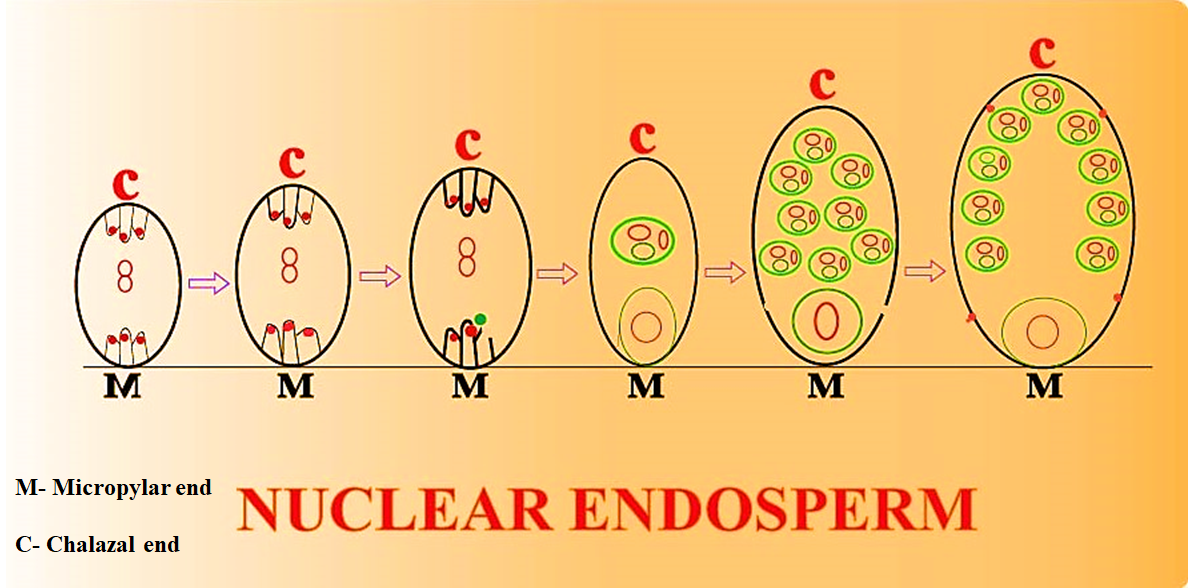
In a nuclear endosperm, which of the following is seen?
(a)Every nuclear division is followed by wall formation
(b)Initially, free-nuclear division followed by wall formation
(c)First division followed by wall formation and other free nuclear
(d)None of the above
Answer
482.4k+ views
Hint:The nuclear endosperm is also known as liquid endosperm as seen in coconut. In coconut, the peripheral endosperm is usually multicellular which is called ‘coconut meal’ while the central part called ‘coconut milk’ is free nuclear.
Complete answer:
The nuclear endosperm is formed by continuous mitotic free nuclear division of the PEN (primary endosperm nucleus) in the central cell of the embryo. Later, the formation of the wall takes place in centrifugal direction i.e. from the periphery of the embryo sac to the center. This is preceded by the formation of a large central vacuole that pushes the free nuclei to the peripheral cytoplasm.
It is the commonest kind of endosperm and is found mainly in polypetalous flowers such as cotton, wheat, sunflower, Zea mays, Capsella, Coconut, etc.
Additional information:
The other two types of endosperm are-
-Cellular endosperm- In this type of endosperm, the nuclear divisions are followed by immediate wall formation. It is seen in Petunia, Datura, Adoxa, etc.
-Helobial endosperm- It is an intermediate type of endosperm in which the first nuclear division is followed by wall formation but the subsequent nuclear divisions take place without any wall formation. It is seen in monocots like Asphodelus.
So, the correct answer is ‘Initially free-nuclear division followed by wall formation’.
Note:
-The endosperm acts as a source of nutrition to the developing seed and consists of starch (mainly), protein, and fatty oils.
-The endosperm of the majority of the angiosperms is triploid except for a few such as, in Nuphor polsepala, the endosperm is diploid.

Complete answer:
The nuclear endosperm is formed by continuous mitotic free nuclear division of the PEN (primary endosperm nucleus) in the central cell of the embryo. Later, the formation of the wall takes place in centrifugal direction i.e. from the periphery of the embryo sac to the center. This is preceded by the formation of a large central vacuole that pushes the free nuclei to the peripheral cytoplasm.
It is the commonest kind of endosperm and is found mainly in polypetalous flowers such as cotton, wheat, sunflower, Zea mays, Capsella, Coconut, etc.
Additional information:
The other two types of endosperm are-
-Cellular endosperm- In this type of endosperm, the nuclear divisions are followed by immediate wall formation. It is seen in Petunia, Datura, Adoxa, etc.
-Helobial endosperm- It is an intermediate type of endosperm in which the first nuclear division is followed by wall formation but the subsequent nuclear divisions take place without any wall formation. It is seen in monocots like Asphodelus.
So, the correct answer is ‘Initially free-nuclear division followed by wall formation’.
Note:
-The endosperm acts as a source of nutrition to the developing seed and consists of starch (mainly), protein, and fatty oils.
-The endosperm of the majority of the angiosperms is triploid except for a few such as, in Nuphor polsepala, the endosperm is diploid.

Recently Updated Pages
Glucose when reduced with HI and red Phosphorus gives class 11 chemistry CBSE

The highest possible oxidation states of Uranium and class 11 chemistry CBSE

Find the value of x if the mode of the following data class 11 maths CBSE

Which of the following can be used in the Friedel Crafts class 11 chemistry CBSE

A sphere of mass 40 kg is attracted by a second sphere class 11 physics CBSE

Statement I Reactivity of aluminium decreases when class 11 chemistry CBSE

Trending doubts
10 examples of friction in our daily life

The correct order of melting point of 14th group elements class 11 chemistry CBSE

Difference Between Prokaryotic Cells and Eukaryotic Cells

One Metric ton is equal to kg A 10000 B 1000 C 100 class 11 physics CBSE

State and prove Bernoullis theorem class 11 physics CBSE

What organs are located on the left side of your body class 11 biology CBSE




